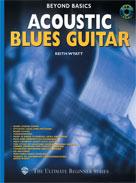ACOUSTIC BLUES GUITAR KEITH WYATT CD TABLATURE LIBRO METODO CHITARRA SPARTITI
By Keith Wyatt
SERIES: Beyond Basics
CATEGORY: Guitar Method or Supplement
FORMAT: Book & CD
Acoustic Blues Guitar teaches blues chord forms, stylistic licks and patterns, blues scales, turnarounds, solo country blues style guitar, independent bass line and melody ideas, and more. The book includes a full-color photo section showing all types of slides. Written in standard notation and tablature.
ACOUSTIC BLUES GUITAR, Keith Wyatt. oltre 50 esempi di frasi e assoli, forma degli accordi, turnarounds, fingerstyle blues, lo stile di Lightnin' Hopkins, Muddy Waters, Lonnie Johnson, Robert Johnson. CD TABLATURE
INTRODUCTION
Welcome to Acoustic Blues Guitar.
In the 1920's and 1930's, there were some great players, such as Lonnie Johnson, Blind
Lemon Jefferson and Robert Johnson. The style and influence of these players established
a tradition that to this day still appeals to everyone from casual listeners to professional musIcians.
This book presents traditional, roots oriented blues with contemporary training methods
that will allow you to immediately understand and apply these useful, versatile concepts to your style.
Section I covers all the basics you will need to know regarding the acoustic blues style:
chord shapes, progressions, chord embellishments. strum patterns, bass-lines, the shuffle
groove and turnarounds. Section II focuses on solo-style blues guitar, demonstrating
musical examples, scales, melodic patterns, licks and fingerpicking.
If you love the blues, have an acoustic guitar and two hands, then you are ready to go to work.
PREFACE
One nice thing about acoustic blues is that you do not need expensive and complicated tools
or devices. The main thing you need is a guitar that is set up well. There are a few simple
tools and devices that you might like to keep in your guitar case: extra strings, picks, slides
[glass or metal) and a capo.
Strings: It is amazing what a fresh set of strings can do to bring out the best sound of a
guitar. If you play regularly, try not to leave the same set of strings on any longer than a month.
You might want to use light or extra-light strings to reduce muscle fatigue and sore
fingertips. Later, lighter strings will enable you to learn the valuable technique of "bending in
pitch" a lot sooner. After you learn this technique correctly, you might want to experiment
with using heavier strings. Different gauges [thickness) of strings have a different sound
quality, and you will need to experiment until you find the sound you like.
Picking Techniques: There are different techniques for striking the strings that you should
experiment with as you learn the examples in the book:
• Playing fingerstyle [without a pick) produces a warm sound, but it's not as clear and you
have to work harder to produce a wide range of volume. This technique is better for solo
style where you combine bass-lines and melody.
• Using a pick will give you a wider range of volume and it is easier to play single-note lines
and melodies. A pick gives you the option of playing single-note melodies with your fingers
and bass-lines with your pick, but you have to train weaker fingers to play fingerstyle
melody-lines. Playing fingerstyle with a flat-pick is often called hybrid-picking.
• A thumb-pick is primarily designed for down-strokes to play fingerstyle bass-lines, but they
are a little awkward for playing single-note melodies.
• Finger-picks are also available, to be combined with the thumb-pick to get a brighter
sound. This technique is used more for banjo than guitar.
The most important thing to consider when choosing a technique is the sound. While you
might find one of these techniques easier than the others, you should still practice the
technique that will give you the best sound even if it takes a little longer. Flat-picks come in a
variety of sizes, shapes and materials that affect the sound and feel. When using a flat-pick,
experiment with different thicknesses and different materials to learn their effect on the sound.
CONTENTS


